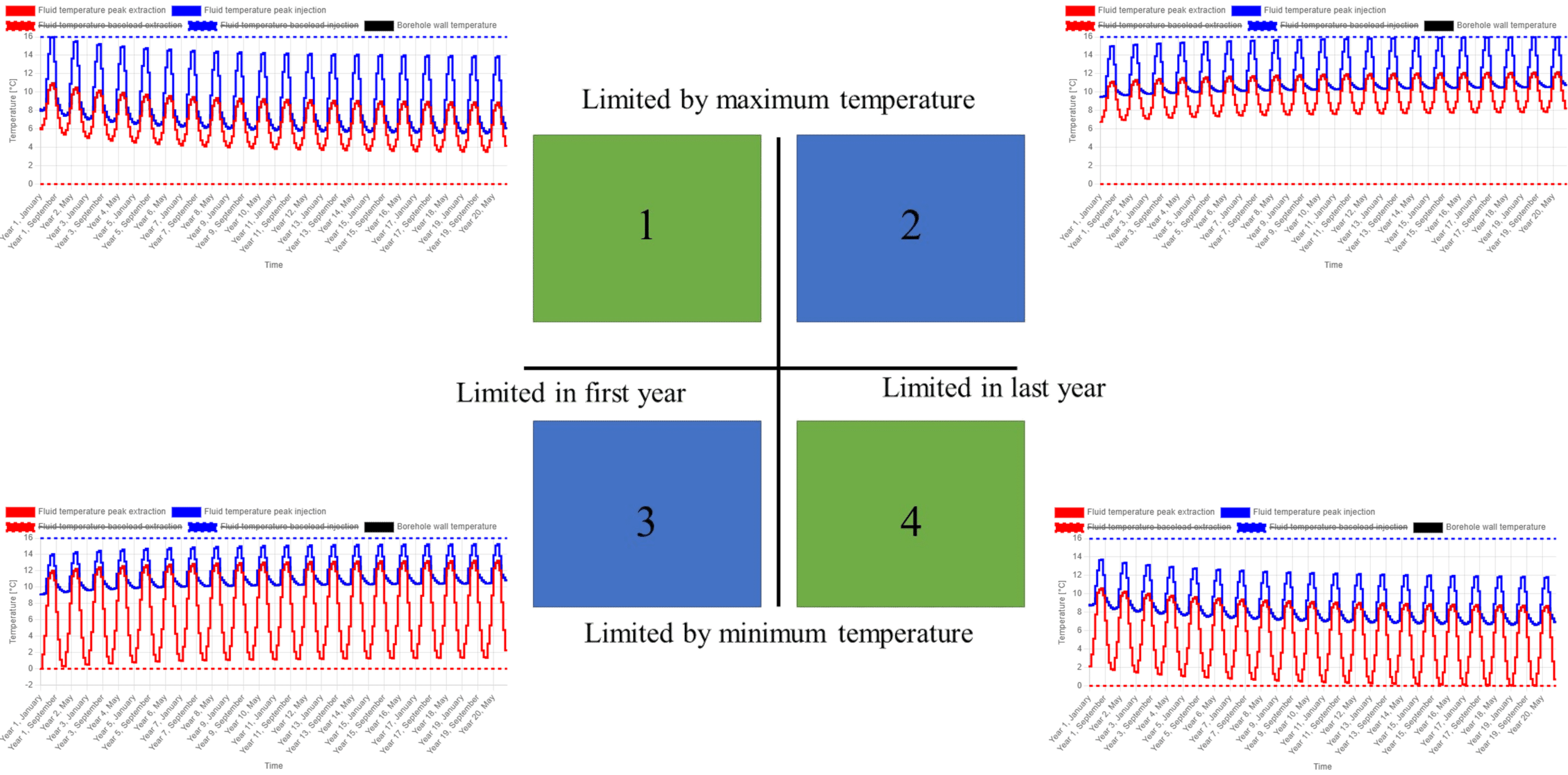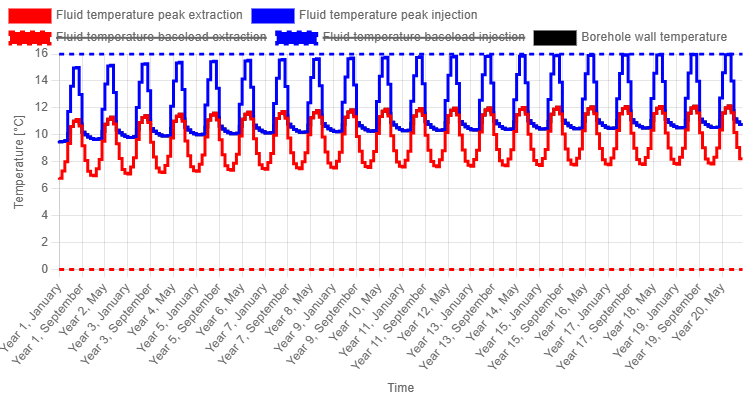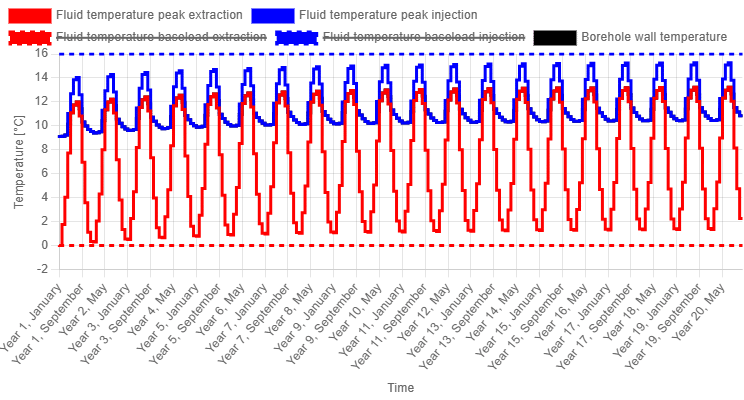Insight is crucial for an accurate borefield design. Borefields are inherently complex due to numerous design parameters and uncertainties. In this article, we introduce the concept of borefield quadrants— a framework that can help you analyse your borefield design and better understand our upcoming articles on borefield physics.
Terminology
Before delving into borefield physics and the insights it provides, we need to introduce some key terminology.
When discussing geothermal energy, we often use terms such as heating and cooling alongside injection and extraction. It is important to understand that these terms refer to different aspects of the system.
- Heating en cooling refer to the building load (also called the secondary load)—the energy exchanged with the building itself.
- Extraction en injection refer to the ground load (also called the primary load)—the energy exchanged with the ground.
Although these concepts are related (e.g., heating a building involves extracting heat from the ground), they are not identical, as a heat pump sits between them. The heating load of the building will always be greater than the heat extracted from the borefield. It is this extraction load that is crucial for the final borefield design.
!Let op
In GHEtool Cloud, you can enter your load as either a building load or a geothermal load. If using the building load, you will also need to provide your SCOP and SEER values.

Another key concept is imbalance and regeneration.
- Imbalance is defined as the net heating up or cooling down of the ground over a year, representing the difference between heat injection and heat extraction (not heating and cooling!). It is negative when the ground continuously cools down year after year due to extraction exceeding injection.
- Regeneration actively addresses this imbalance by injecting or extracting additional heat into/from the ground to restore equilibrium. This can be achieved using solar thermal collectors, dry coolers, and other technologies.
!Let op
Instead of managing imbalance and regeneration directly, you can also implement a hybrid system. More information on the advantages of hybrid systems can be found in this article.
Different temperature plots
Before introducing the concept of borefield quadrants, let us first examine several different temperature profiles. (If you have not yet read the article on how to interpret temperature profiles, you can find it hier.)
The temperature profile below illustrates a borefield with a negative imbalance (as it cools down year after year) but without reaching the minimum temperature limit. Instead, it reaches the maximum allowed average fluid temperature in the first year of the simulation period, meaning that the borefield should be designed based on this point. This profile could correspond to an auditorium in the mild climate of Belgium, where there is a higher annual heating demand than cooling demand, but the building’s cooling peak exceeds its heating peak.
The next temperature plot demonstrates the opposite imbalance, where the ground heats up year after year and eventually reaches the maximum allowed average fluid temperature. This means the borefield should be designed to accommodate the building’s cooling peak in the final year of the simulation period. This profile could represent an office building with significant internal gains or even a data centre, where the annual cooling demand exceeds the heating demand.
The third temperature plot also exhibits a negative imbalance, but in contrast to the first example, it reaches the temperature limit in the final year of the simulation period. This is typical of buildings in colder climates, where heating demand and heating peaks are more pronounced.
The final profile displays a positive imbalance (injection-dominated), where the system is constrained by the minimum allowed average fluid temperature in the first year of operation.
Borefield quadrants
The four profiles can be considered archetypes for the four different borefield quadrants. Every temperature profile you encounter can be categorised into one of these four borefield quadrants: either constrained by the maximum or minimum average fluid temperature, and either in the first or the last year of the simulation period.

A priori insight
The key advantage of categorising borefields into different borefield quadrants is that it allows you to reason about certain geothermal questions without the need for further calculations. Below, we answer three common questions purely by considering the borefield quadrants.
When is imbalance/regeneration relevant for investment cost?
It is often said that regeneration reduces borefield investment costs, but this is not always the case. If a borefield falls into quadrant 1 or 3, where the design limitation occurs in the first year of operation, imbalance does not pose a problem. In contrast, in quadrants 2 and 4, reducing imbalance through regeneration leads to a smaller borefield, as the system is designed based on the final year of the simulation, when accumulated imbalance has the greatest impact.
When is drilling deeper advantageous?
For buildings with high heating demand, drilling deeper can be beneficial because ground temperatures increase with depth. This means that borefields in quadrants 3 and 4 can benefit from deeper boreholes, while quadrants 1 and 2 will not, as they are designed primarily for heat injection rather than heat extraction.
!Let op
Borefield design software generally assumes that ground temperature increases linearly with depth. However, in densely built areas, the upper ground layers may already be warmer due to the urban heat island effect. In such cases, drilling deeper might, depending on the depth, actually result in a cooler borefield rather than a warmer one.
When is active cooling advantageous?
Active cooling can be a highly effective way to optimise investment costs, but only for borefields designed to handle high heat injection demands. With active cooling, the temperature limitation shifts from typically 16–17°C (for passive cooling) to 25°C or higher, allowing for a smaller borefield and thus lower investment costs. This is beneficial in quadrants 1 and 2, but not in quadrants 3 and 4.
!Let op
Technically, borefields in quadrant 4 could benefit slightly from active cooling, as the lower SEER (compared to passive cooling) reduces imbalance. However, this effect is far smaller than the impact seen in quadrants 1 and 2.
Conclusie
This article clarified the distinction between building load terminology and ground load terminology. We then introduced the concept of borefield quadrants, demonstrating how this framework allows you to reason about geothermal system design without requiring complex calculations.
This foundational knowledge will be expanded upon in future articles, offering deeper insights into borefield physics and empowering you to design borefields with confidence!
Referenties
- Bekijk onze video over dit artikel op onze YouTube pagina hier.
- More information on borefield quadrants can be found in (Peere et al., 2021).



